Imagine a customer discovering a moth hole in their brand-new garment—it’s not the impression you want to leave! Pests like moths, rodents, and insects damage your precious products and threaten the trust and reputation you’ve worked so hard to build. As a garment industry professional, you know firsthand the frustration and financial strain of battling these pests.
Pests can wreak havoc on every aspect of your business, from chewing through fabrics to contaminating storage areas. They don’t discriminate—nothing is safe, whether it’s your raw materials or finished products.
Fortunately, there are many pest control procedures in the garment industry you can opt for to get rid of persistent pest infestations and save your business from potential damages. In this blog, we will discuss these procedures and how you can implement them for the best outcomes.
Why Are There Pests in the Garment Industry?
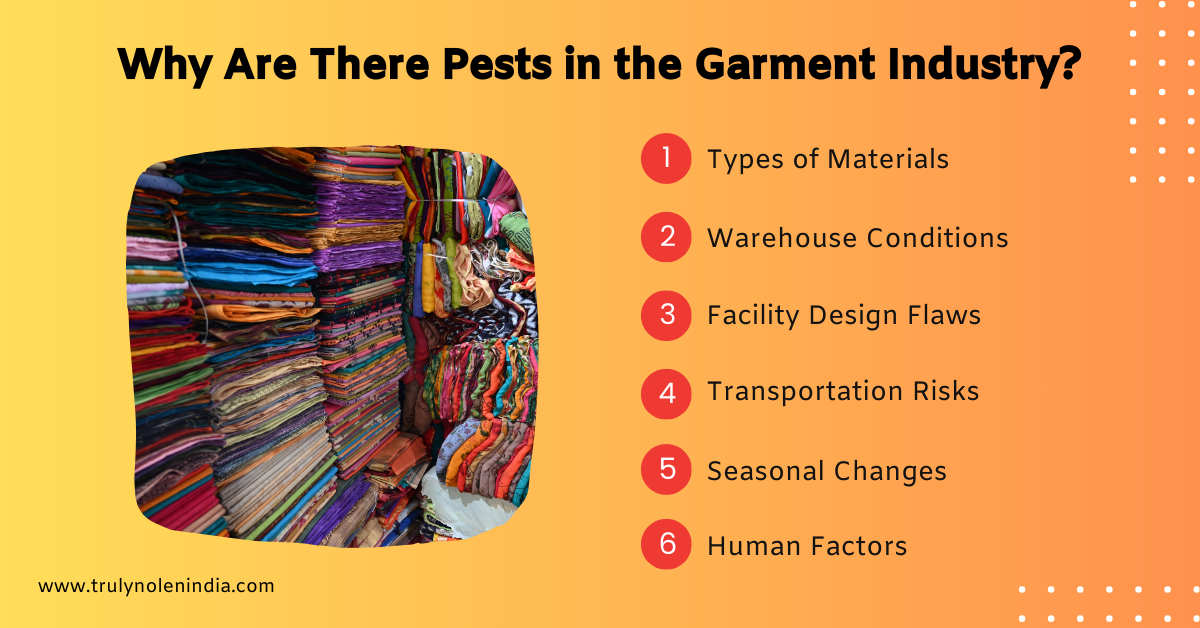
Due to various factors, the garment industry is particularly prone to pest infestations. Understanding these factors is essential for implementing effective pest control procedures in the garment industry.
- Types of Materials: Due to their organic composition, natural fibers such as cotton and wool are prone to infestation by moths and beetles. Similarly, synthetic fibers and dyes, while less susceptible, can still attract certain pests, albeit in different ways.
- Warehouse Conditions: Sufficient temperature and humidity provide ideal breeding conditions in storage areas. Leftover food and fabric scraps attract rodents and insects. Moreover, high humidity levels in specific warehouses provide a perfect environment for pests such as silverfish and mold to thrive.
- Facility Design Flaws: Poor ventilation creates environments conducive to pests thriving in moisture. Inefficient waste management systems further exacerbate the issue, becoming breeding grounds for various pests. Additionally, openings such as unsealed doors and windows serve as easy access points for pests.
- Transportation Risks: Transporting fabrics and garments poses cross-contamination risks, potentially spreading pests from one facility to another. Therefore, the garment industry must implement a comprehensive pest control procedure to mitigate these risks and ensure the integrity of products during transportation.
- Seasonal Changes: Pests vary according to temperature fluctuations, with some thriving in warmth while others prefer colder climates. Similarly, humidity variations throughout the seasons influence pest populations within garment facilities.
- Human Factors: Employees may unknowingly bring pests into the workspace or create conducive environments for infestations through improper food storage practices. Furthermore, a lack of staff awareness regarding the signs of pest infestation and preventive measures further complicates the issue.
Understanding these attractants and environmental factors is critical for effective pest control procedures in the garment industry. Strategies must include reactive measures to deal with infestations and proactive steps to prevent them.
Types of Pests in the Garment Industry
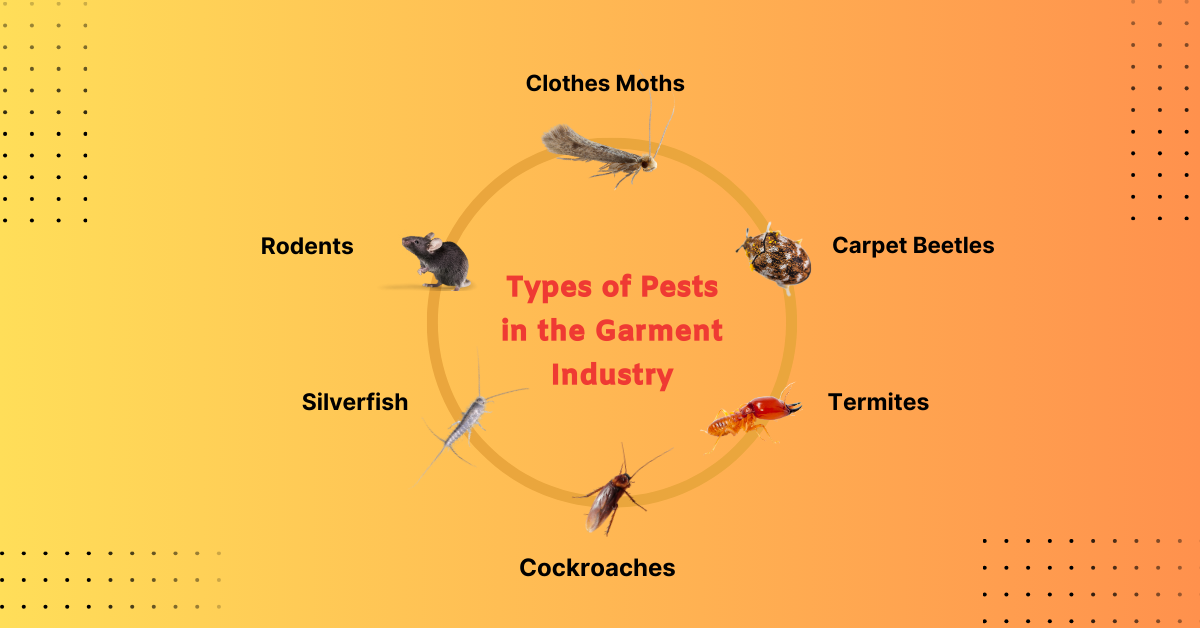
When it comes to pest control procedures in the garment industry, identifying the types of pests commonly found in this sector is essential. Different pests pose varying threats and require specific strategies. Here are some of the most common pests found in the garment industry:
- Clothes Moths: These insects are notorious for damaging fabrics. They are particularly attracted to natural fibers like wool, silk, and cotton.
- Carpet Beetles: Similar to clothes moths, carpet beetles feed on natural fibers and can cause considerable damage to garments and upholstery.
- Silverfish: These pests are attracted to starches and can damage anything from cotton and linen to synthetic fabrics. Addressing silverfish is critical to ensuring effective pest control procedures in garment industry.
- Rodents: Mice and rats can be problematic in warehouses and storage areas. They damage fabrics and pose health risks, making rodent control a key part of the pest control procedure in the garment industry.
- Cockroaches: Often attracted to the glues used in garment packaging and can contaminate fabrics with the cockroaches‘ droppings.
- Termites: In regions prone to termite infestation, these pests can damage wooden structures in warehouses, indirectly affecting garment storage. Thus, the pest control procedure in the garment industry requires attention.
Each of these pests requires a tailored approach within the pest control procedure in the garment industry. Understanding their behavior, preferred habitat, and the damage they can cause is essential in devising effective control and prevention strategies. Implementing a comprehensive pest control procedure in the garment industry that addresses these diverse threats is vital for protecting the quality and integrity of the products in this sector.
Pest Control Procedure in the Garment Industry: Effective Steps
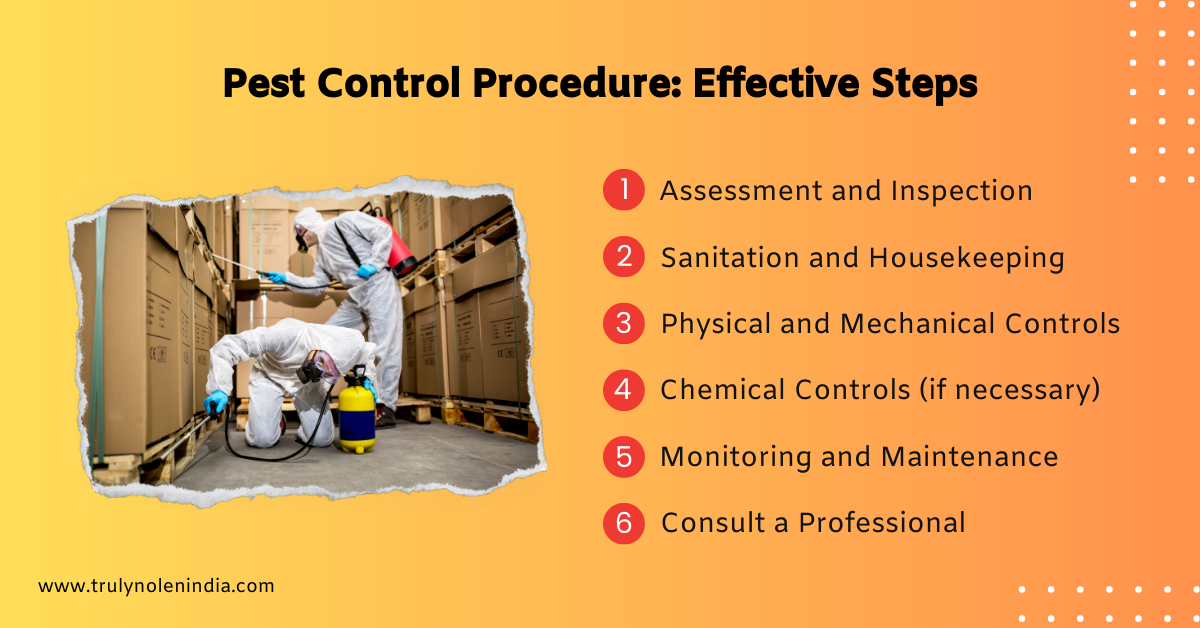
Understanding the pest control procedure in the garment industry is crucial to maintaining product quality and ensuring a safe working environment. Here are the typical steps involved:
- Assessment and Inspection
This crucial first step requires a detailed examination of the entire garment manufacturing facility to identify potential pest entry points, areas where infestations may have occurred, and the types of pests present. Inspectors conduct a systematic review, looking for clear signs of pest activity such as droppings, gnaw marks, damage to materials, and actual sightings of pests.
Special attention is given to key areas like fabric storage, where textiles can attract pests, and waste disposal zones, which can often be breeding grounds for insects and rodents. This step also involves assessing the facility’s general cleanliness, as poor sanitation can contribute to pest problems. Inspectors might also use tools like UV lights or tracking powders to reveal less obvious signs of pest presence.
The objective is to gain a complete understanding of the current pest situation and potential risks, laying the groundwork for an effective pest control strategy tailored to the garment industry’s unique needs. This thorough assessment helps formulate a more targeted and effective approach to pest management.
- Sanitation and Housekeeping
Sanitation and housekeeping are crucial for pest control procedures in the garment industry, emphasizing the need for high cleanliness standards. Regular cleaning is key, focusing on eliminating food sources and debris that attract pests, especially in employee areas where fabrics are processed. Fabric and raw material storage areas require particular attention, keeping them orderly and off the floor to deter pests.
Effective waste management is also vital, as garment facilities produce waste like fabric offcuts and chemical containers that can attract pests. Using sealed containers and prompt waste disposal minimizes infestation risks. Educating employees on sanitation best practices, including recognizing and reporting pest issues, is essential. This collective effort to maintain hygiene is fundamental to effective pest management in the industry.
- Physical and Mechanical Controls
Physical and mechanical controls are essential in pest management in the garment industry. This approach involves installing barriers like screens, door sweeps, and air curtains to block pest entry and using mechanical traps to capture them. Screens must be fine enough to prevent small insects, while traps vary based on pest type—pheromone traps for moths and snap traps for rodents.
The effectiveness of these methods hinges on regular inspection and maintenance. It’s important to routinely check and repair barriers and ensure traps are properly placed and functional. These controls are strategically positioned at potential entry points and areas prone to pest activity, like where food or fabric waste accumulates. Focusing on prevention and safety, this approach is vital in maintaining a pest-free environment in the garment industry.
- Chemical Controls (if necessary)
When persistent infestations occur in the garment industry, the judicious use of chemical pesticides becomes necessary. It’s crucial to select safe chemicals for fabric environments and apply them to minimize exposure to workers and materials. Targeted application, preferably outside regular working hours, helps reduce potential contact with fabrics and employee exposure.
Adhering to safety and environmental regulations, including proper pesticide storage, handling, and usage according to manufacturer guidelines, is paramount. Workers should be provided with and trained in using appropriate personal protective equipment. Chemical controls should be integrated into a broader pest management strategy, utilized as a last resort, and combined with other methods like sanitation and physical barriers. Regular evaluations of pest management strategies ensure the effectiveness and safety of chemical usage in maintaining a pest-free garment production environment.
- Monitoring and Maintenance
Monitoring the facility is crucial to assessing the effectiveness of pest control measures. This involves regular inspections of traps, barriers, and the facility to detect new signs of pest activity. Monitoring tools such as pheromone traps may be used for early detection of infestations. Based on these observations, the strategy should be adjusted, which might include changing the placement of traps, altering cleaning routines, or modifying storage practices.
Employee involvement in reporting pest sightings is also important, as it contributes to the overall effectiveness of the pest management program. This phase is a cycle of ongoing evaluation and adaptation, ensuring that the environment remains conducive to maintaining high-quality garment production standards.
- Consult a Professional
Engaging the services of a professional pest control expert, particularly one with experience in the garment industry, is a crucial step for a thorough and effective pest management strategy. These specialists bring knowledge and expertise in identifying and dealing with various pests in garment production and storage environments. They are equipped to provide expert advice on the most effective and safe pest control methods, ensuring that these techniques do not adversely affect the fabric or the working conditions within the facility.
Professional pest control services often offer customized solutions tailored to a specific facility’s unique needs and challenges. This customization is vital because the layout, location, type of fabrics handled, and the specific pest threats can vary significantly between garment factories. Additionally, regular assessments conducted by these professionals can be invaluable in the early detection of potential pest infestations. Early detection is key to preventing minor, manageable issues from escalating into full-blown infestations that can cause significant damage and cost.
Protect Your Garment Business from Pests with Truly Pest Solution
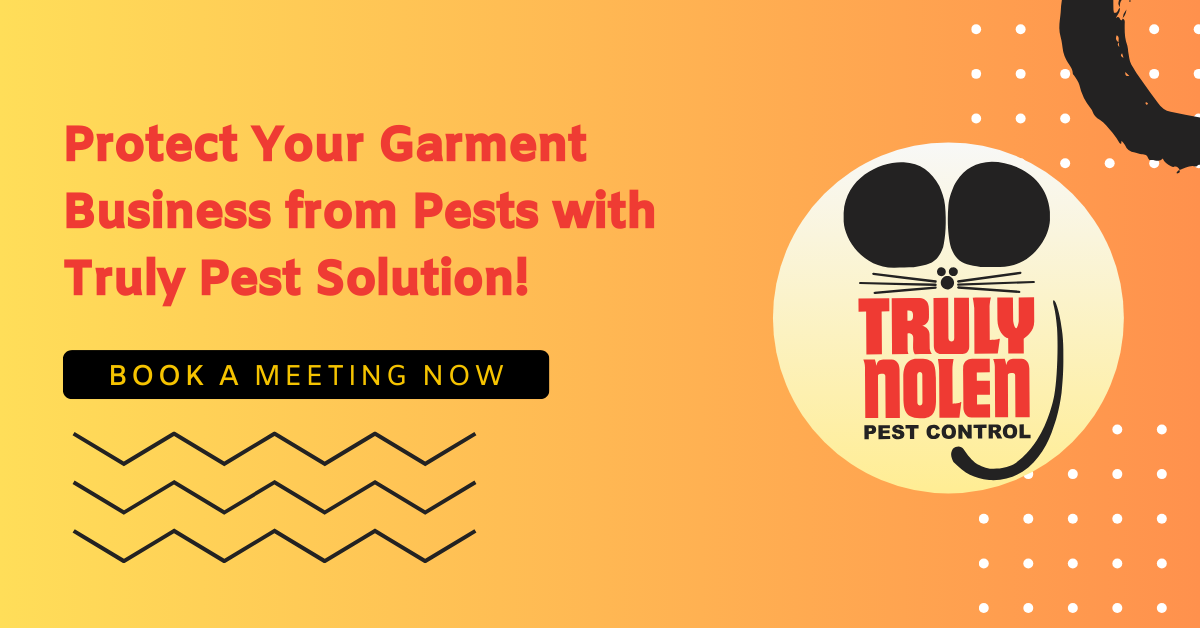
Effective pest control is essential in the garment industry to protect product integrity, ensure worker safety, and maintain high-quality standards. Understanding the types of pests and their attractants is key to developing successful control strategies. Implementing thorough inspection, regular maintenance, and involving professionals with industry-specific expertise are critical steps. Ultimately, a robust pest control procedure is not just about eliminating pests but sustaining a safe, efficient, and reputable operation in the garment industry.
At Truly Pest Solution, our holistic strategy involves detailed assessments of your premises to detect and manage current infestations. We collaborate closely with you through regular follow-up inspections and preventive treatments to establish preventive measures and resolve potential trouble spots.
Don’t let pests take over your business. Contact Truly Pest Solution today.
Book a meeting now!
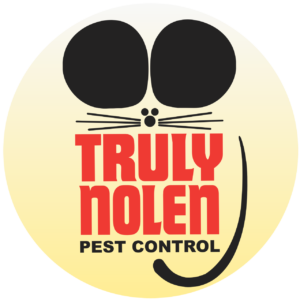
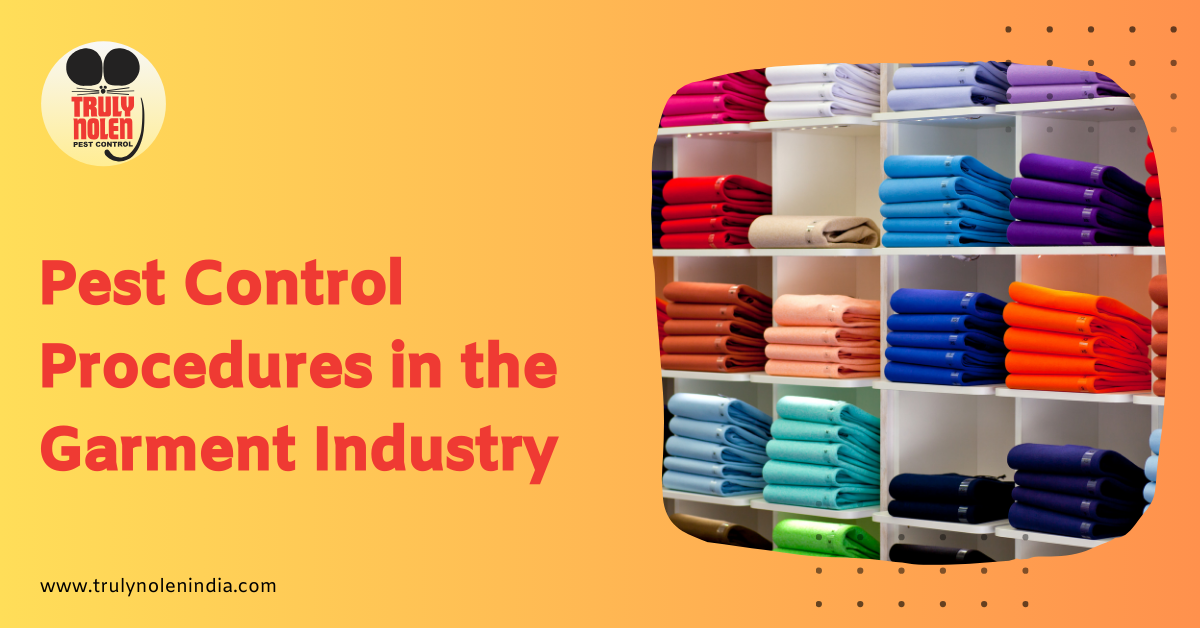
Leave a Reply